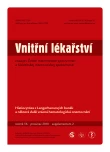Necrobiotic xanthogranuloma – a rare cutaneous complication in a patient with multiple myeloma
Authors:
L. Zahradová 1; Z. Adam 1; J. Feit 2; J. Stupalová 3; R. Koukalová 3; R. Hájek 1; J. Mayer 1
Authors‘ workplace:
Interní hematoonkologická klinika Lékařské fakulty MU a FN Brno, pracoviště Bohunice, přednosta prof. MUDr. Jiří Mayer, CSc.
1; Ústav patologie Lékařské fakulty MU a FN Brno, pracoviště Bohunice, přednosta prof. MUDr. Josef Feit, CSc.
2; Oddělení nukleární medicíny a pozitronové emisní tomografie Masarykova onkologického ústavu Brno, přednosta prim. MUDr. Karol Bolčák
3
Published in:
Vnitř Lék 2010; 56(Supplementum 2): 179-182
Category:
Langerhans cell histiocytosis and some other Hematology rare diseases
Overview
Necrobiotic xanthogranuloma is a rare chronic destructive granulomatous disease of the skin, the incidence of which is being associated with concurrent presence of monoclonal gammopathy. The presence of a lesion might be linked to subjective symptoms such as burning, feeling of tension or pain. Because of its rare incidence, optimum treatment is not known. Despite partial treatment success, the disease tends to recur. The present paper describes a case of an 87 years old patient with this rare cutaneous complication. The patient was followed up from the age of 76 for long-term stable monoclonal gammopathy of unknown significance. In March 2008, painless swelling occurred on the left forearm; histological examination suggested granulomatous changes of uncertain aetiology. A new health complaint occurred in January 2009 in a form of pain in the area of the right Achilles tendon. Subsequently, painful indurations have developed over a period of several months in the crura of both legs, with a maximum in the area of both Achilles tendons. Histological examination of biopsy specimens identified an extensive necrobiotic xanthogranuloma, the finding was the same as that for the formation found in the forearm. Considering this finding and the proposed treatment, trephine biopsy was performed, where 10–15% of plasma cells were detected; the diagnosis was, therefore, reviewed and changed to multiple myeloma. As part of the disease re-evaluation, PET/CT was performed that showed multiple cutaneous and subcutaneous infiltrates with a maximum in both crura with SUV up to 10. Considering the age and co-morbidities, we selected oral combination treatment with cyclophosphamide and prednisone and, considering the high level of pathologically active tissue, analgesic radiotherapy was performed at painful foci in the area of Achilles tendons. This resulted in regression of the foci and, importantly, pain relieve. Unfortunately, soreness of the foci had worsened 1–2 months after radiotherapy completion. Laboratory results showed the minimum response evaluated according to a reduction of monoclonal immunoglobulin. However, no further reduction was observed after 6 cycles and thus the treatment was terminated. Further treatment of the patient is difficult because of his age and co-morbidities; at present, he is on symptomatic treatment only.
Key words:
multiple myeloma – necrobiotic xanthogranuloma – cutaneous foci – granulomatous disease
Sources
1. Harati A, Brockmeyer NH, Altmeyer P et al. Skin disorders in association with monoclonal gammopathies. Eur J Med Res 2005; 10 : 93–104.
2. Winkelmann RK, Dahl PR, Perniciaro C. Asteroid bodies and other cytoplasmatic inclusions in necrobiotic xantogranuloma with paraproteinemia. J Am Acad Dermatol 1998; 38 : 967–970.
3. Randell PL, Heenan PJ. Necrobiotic xanthogranuloma with paraproteinaemia. Australas J Dermatol 1999; 40 : 114–115.
4. Wood AJ, Wagner MV, Abbott JJ et al. Necrobiotic xanthogranuloma: a review of 17 cases with emphasis on clinical and pathologic correlation. Arch Dermatol 2009; 145 : 279–284.
5. Winkelmann RK, Litzow MR, Umbert IJ et al. Giant cell granulomatous pulmonary and myocardial lesions in necrobiotic xanthogranuloma with paraproteinemia. Mayo Clin Proc 1997; 72 : 1028–1033.
6. Bullock JD, Bartley GB, Campbell RJ et al. Necrobiotic xanthogranuloma with paraproteinemia: case report and pathogenetic theory. Trans Am Opthalmol Soc 1986; 84 : 342–354.
7. Hafner O, Witte S, Schmidt RE et al. Necrobiotic xanthogranuloma in IgG kappa plasmacytoma and Quincke edema. Hautarzt 1994; 45 : 339–343.
8. Fernández-Herrera J, Pedraz J. Necrobio-tic xanthogranuloma. Semin Cutan Med Surg 2007; 26 : 108–113.
9. Zelger B, Eisendle K, Mensing C et al. Detection of spirochetal microorganisms by focus-floating microscopy in necrobiotic xantogranuloma. J Am Acad Dermatol 2007; 57 : 1026–1030.
10. Robertson DM, Winkelmann RK. Ophthalmic features of necrobiotic xanthogranuloma with paraproteinemia. Am J Ophthalmol 1984; 97 : 173–183.
11. Finan MC, Winkelmann RK. Necrobiotic xanthogranuloma with paraproteinemia. A review of 22 cases. Medicine (Baltimore) 1986; 65 : 376–388.
12. Martínez Fernández M, Rodríguez Prieto MA, Ruiz González I et al. Necrobiotic xanthogranuloma associated with myeloma. J Eur Acad Dermatol Venereol 2004; 18 : 328–331.
13. Silapunt S, Chon SY. Generalized necrobiotic xantogranuloma succesfully treated with lenalidomide. J Drugs Dermatol 2010; 9 : 273–276.
14. Adam Z, Zahradová L, Krejčí M et al. Difuzní a plošná normolipidemická xantomatóza a nekrobiotický xantogranulom, asociované s monoklonální gamapatií – přínos PET-CT pro stanovení rozsahu nemoci a zkušenosti s léčbou. Popis dvou případů a přehled literatury. Vnitř Lék 2010; 56 : 1158–1168.
Labels
Diabetology Endocrinology Internal medicineArticle was published in
Internal Medicine

2010 Issue Supplementum 2
Most read in this issue
- Hemophagocytic lymphohistiocytosis syndrome
- Erdheim-Chester disease in pictures
- Systemic mastocytosis
- Langerhans cell histiocytosis in children and adolescents
